
|
|
Für die deutsche Fassung bitte nach unten scrollen
|
|
Our Major Spring Exhibition:
"Egypt's Eternal Beauty"
|
|
|
It is kind of a renaissance: While numerous countries around the world awake from lockdowns, art life is beginning to blossom again in many places. From May on we will also reopen our galleries in Vienna, and we will celebrate this opening in a very special way: With an exhibition in our showroom honouring "Egypt's eternal beauty". We will present objects of museum-quality, such as the bronze solar barque finial, of which there are only two comparable examples known worldwide – one in Cairo, the other one in Lisbon. We show unique animal mummies, like the cat from the world-famous collection Hilton-Price. And: In addition to newly acquired reliefs, we are introducing for the first time the impressive collection of no less than ten monumental sarcophagus and mummy masks, which we were able to acquire early this year in France.
|
Visit us from May, 3 daily from 10 a.m. to 6 p.m. in Untere Viaduktgasse 55. We are looking forward to meeting you in person again, surrounded by "Egypt's eternal beauty".
|
|
|
|
Our Highlight of the Month:
|
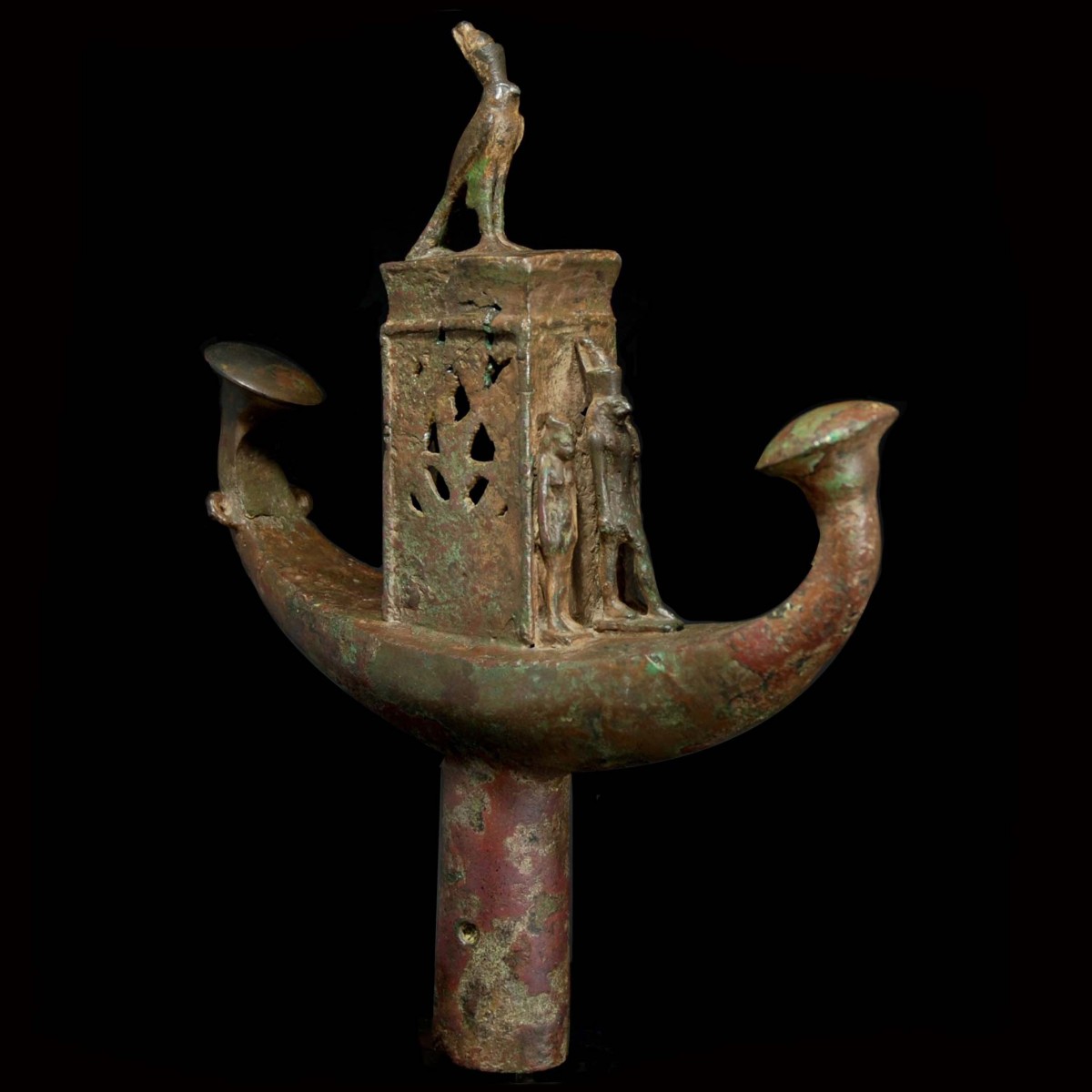
|
|
|
|
|
|
Egypt – Late period, 26th to 30th Dynasty, 380-343 B.C.
|
One of the very few remaining bronze solar boat finials that were used for processions and ceremonies in the Late Period. The barge with a semi-circular hull and a cylindrical extension in the centre, into which the attachment is affixed. Prow and stern in the form of stylized lotus flowers, just below the stern two eyelets. In the middle of the boat is a naos, the side walls in openwork. In front of it stands the falcon-headed god Horus with a double crown (Pschent), flanked by the goddesses Isis and Nephthys. The naos is crowned by a Horus falcon with a Pschent. Apart from this bronze solar barge, only two more complete ones are known. The most famous one is from Pharaoh Djedhor in the Calouste Gulbenkian Museum in Lisbon (inventory number 168). Another complete bronze barge is in the Egyptian Museum, a fragment is in the Museum Vleehuis in Antwerp (Accession Number 79.1). Mounted.
|
Provenance: Private collection of the French architect Michel Holley, acquired on October 20, 1972. With a French antiquities passport and a photo from 1972 depicting the barge.
Dimensions: 30 cm x 24 cm
Price: 80 000 Euro
|
|
|
|
Selected Artworks of the Month:
|

|
|
|
|
|
|
Egypt – Ptolemaic period, 332-30 B.C.
|
Mummified cat wrapped in brown linen. The body tied up in cylindrical form and sewed at the back. The head is modelled, mouth, whiskers, nose and eyes are painted. The ears are raised. On the side an old collection label. An enclosed label refers to the site Beni Hassan. Published in “A Catalogue of the Egyptian Antiquities in the Possession of F. G. Hilton-Price”, Dir. S.A., London 1897, page 317, number 2074. Mummified cats such the present one were sacrificed in honor of the goddess Bastet. If a believer bought a cat of his choice, it was killed by a priest. The priest then processed the dead cat in the same traditional manner of mummification that was common with humans. The buyer then placed the mummy in a tomb especially dedicated for the purpose of cat sacrifices. Mounted.
|
Provenance: Private collection F. G. Hilton-Price prior to 1897. Thence auctioned with Sotheby, Wilkinson & Hodge London in July 1911, lot 1024. With original auction sticker. Thence in private estate. Last at the English art market.
Dimensions: 57 cm high
Price: 14 000 Euro
|
|
|
|
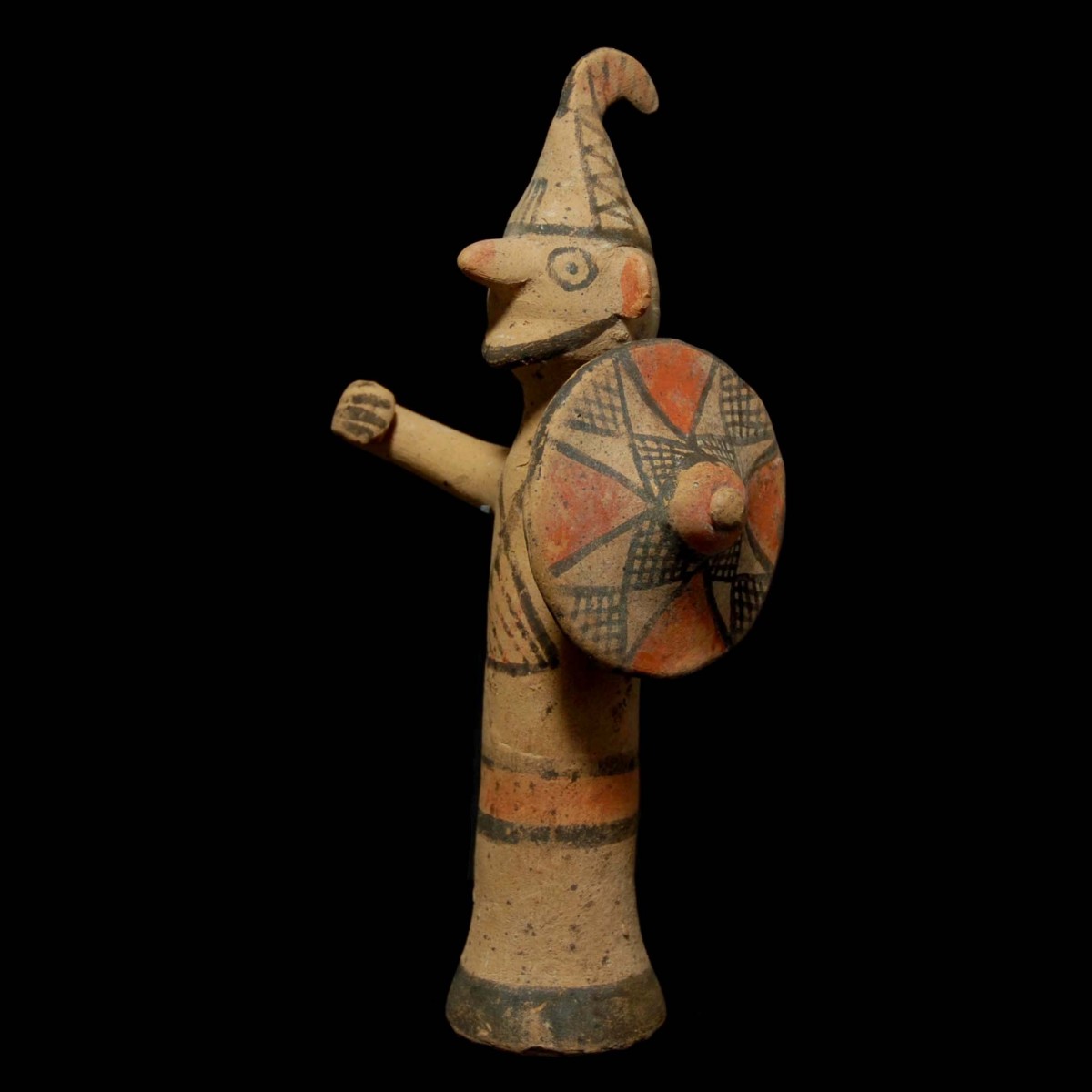
|
|
|
|
|
|
Cyprus – 7th century B.C.
|
For its quality and size very rare terracotta statuette of a warrior dating to the Archaic Period. The body, formed on a pottery wheel, is cylindrical and hollow inside. The tapering head with semi-circular, protruding ears, long, pointy nose and painted eyes and beard. The warrior wears a helmet with a crest turned backward. The left hand holds a circular shield with button-like stud. In his right hand, stretched out to the side, he once possibly held a spear. Magnificently preserved red and black paint. Figures like the present one were found in the sanctuary Agia Irini and other rural shrines in Cyprus. See for the type the example in the Medelhvsmuseet in Stockholm with the inventory number A.I. 0342.
|
Provenance: Old New York private collection. Thence US private collection Daryl Gruber Kulok (1960-2019). There acquired by the gallery Art of Eternity New York. Last in the auction "Exceptional Antiquities, Asian, Ethnographic" on 13 February 2020, lot 17e. With TL test.
Dimensions: 19.7 cm high
Price: 12 000 Euro
|
|
|
|
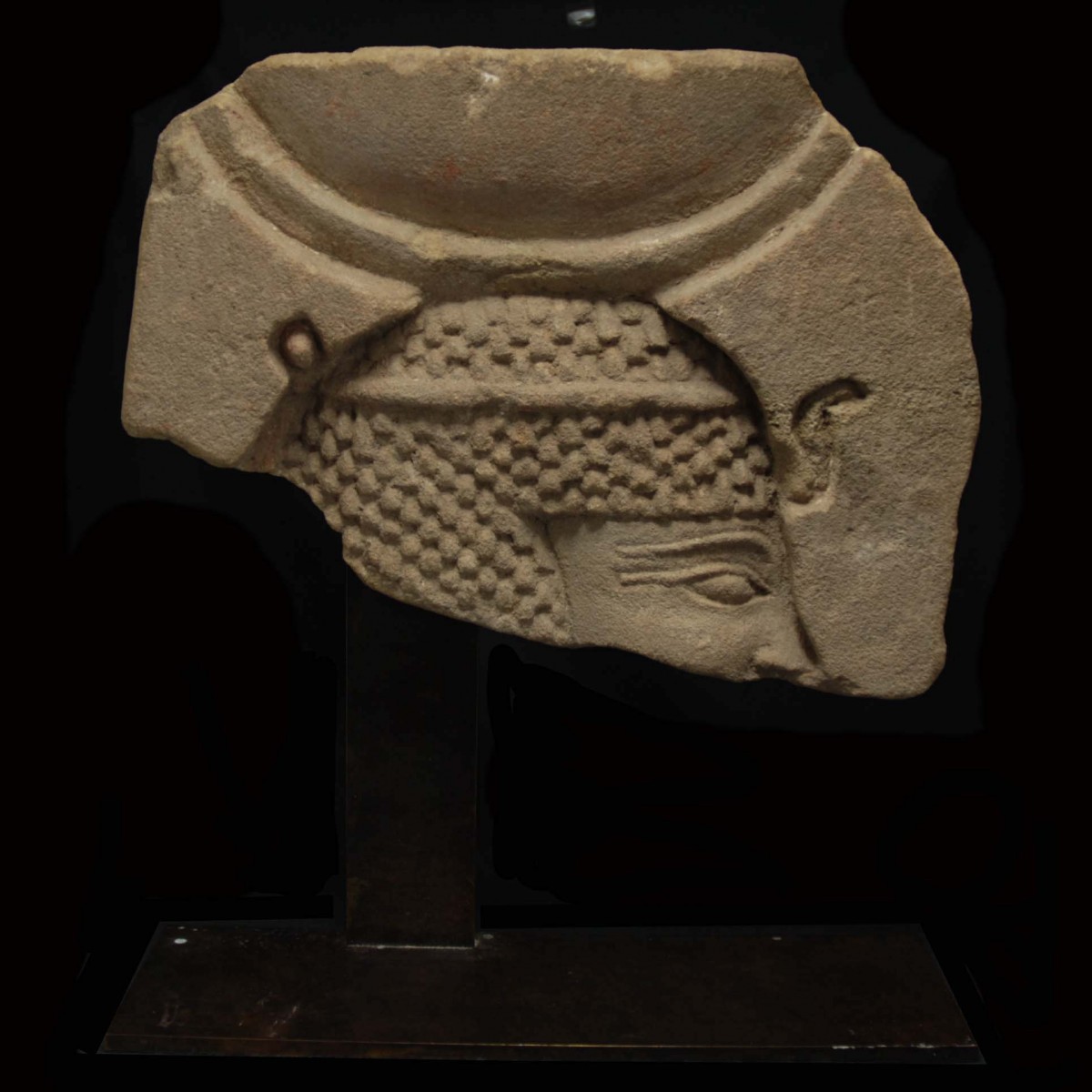
|
|
|
|
Egypt – Ptolemaic period, 332-30 B.C.
|
Large fragment of a sunk limestone relief depicting the head of a pharaoh. He wears a short wig with tightly set curls, the so-called Ibes wig, which is surrounded by a Seshed hairband with a ribbon at the back. The hairband is considered a sign of rebirth and was of great importance in the belief in the dead. On the forehead a uraeus. The pharaoh wears the moon crown of Khonsu as a headdress, at the bottom with the sickle of the new moon, on top with the full moon. It is therefore a deified representation of the king in reference to the moon god Khonsu. With red color remains. Mounted.
|
Provenance: Private collection of of professor Dr. Roland Bay, Basel, acquired 1950. Thence in the Parisian private collection F. A., 1960s to 1970s. Last with Jerome Eisenberg in the gallery Royal Athena in New York. Accompanied by a French antiquities passport.
Dimensions: 22.7 cm x 29.6 cm
Price: 10 000 Euro
|
|
|
|
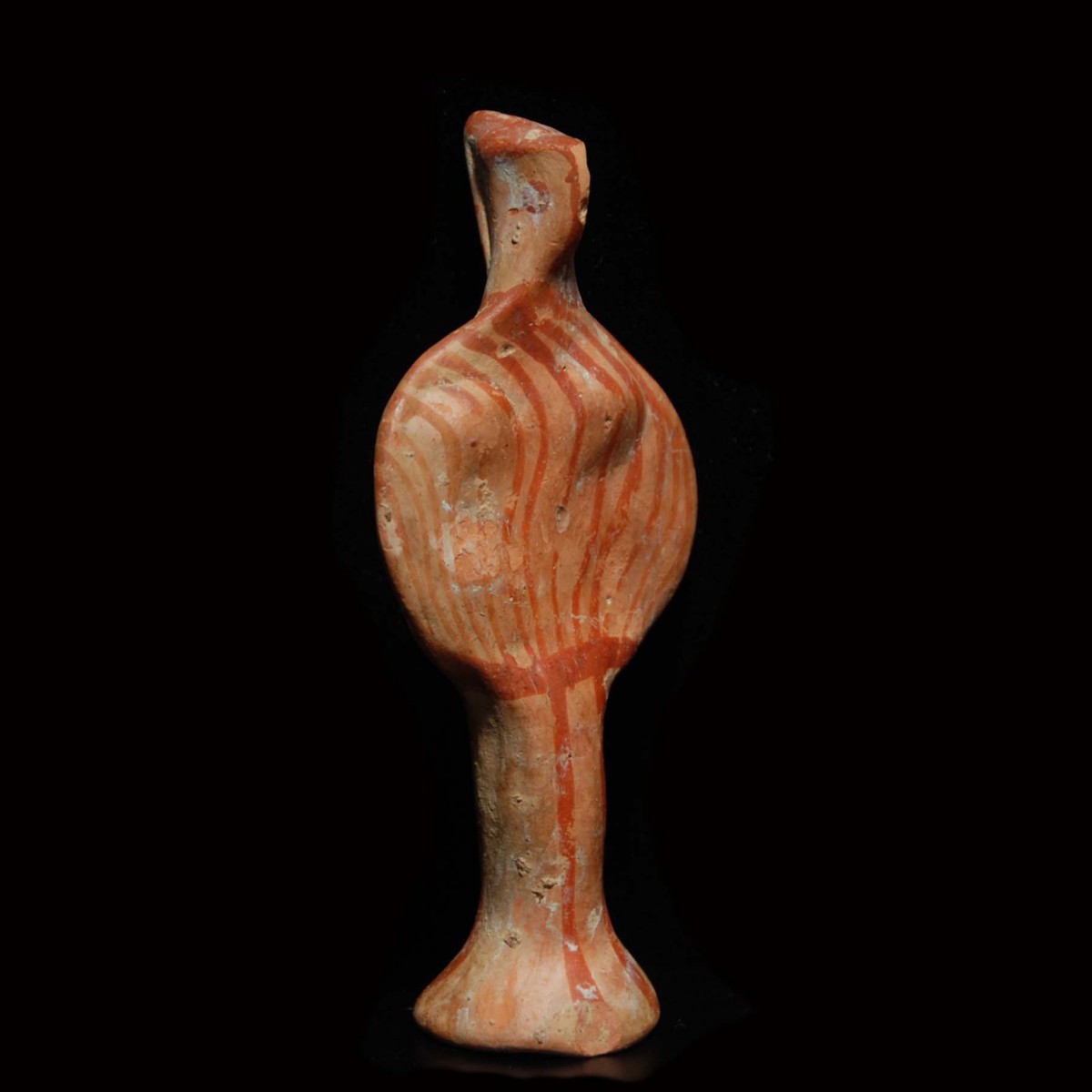
|
|
|
|
|
Stylized idol of a female worshipper which is due to its form named after the Greek letter Φ (Phi). The bird-like head with long, semi-circular nose and an ascending calotte at the back. A long pigtail cascades on the back to the middle of the figure. The flat upper body is circular, the small breasts are spherical. The upper body merges to an also stylized, cylindrical lower body which opens up to a foot ring. The entire body is decorated with wavy, red-brown lines. On the lower body vertical red lines. On the neck and between the upper- and lower body a horizontal separation line.
|
Provenance: From the inventory of the judicially dissolved Parisian gallery La Reine Margot.
Dimensions: 10 cm high
Price: 6 000 Euro
|
|
|
|
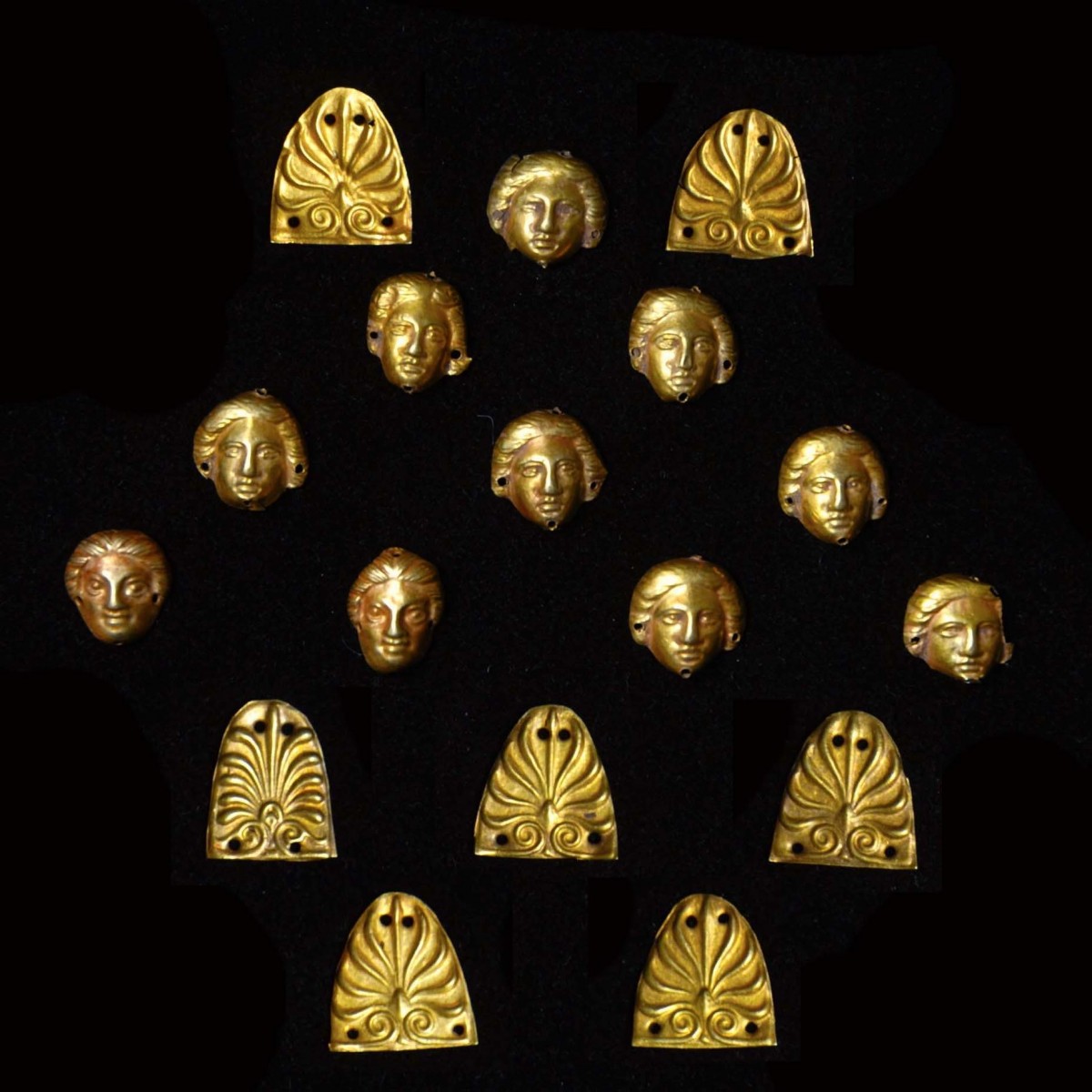
|
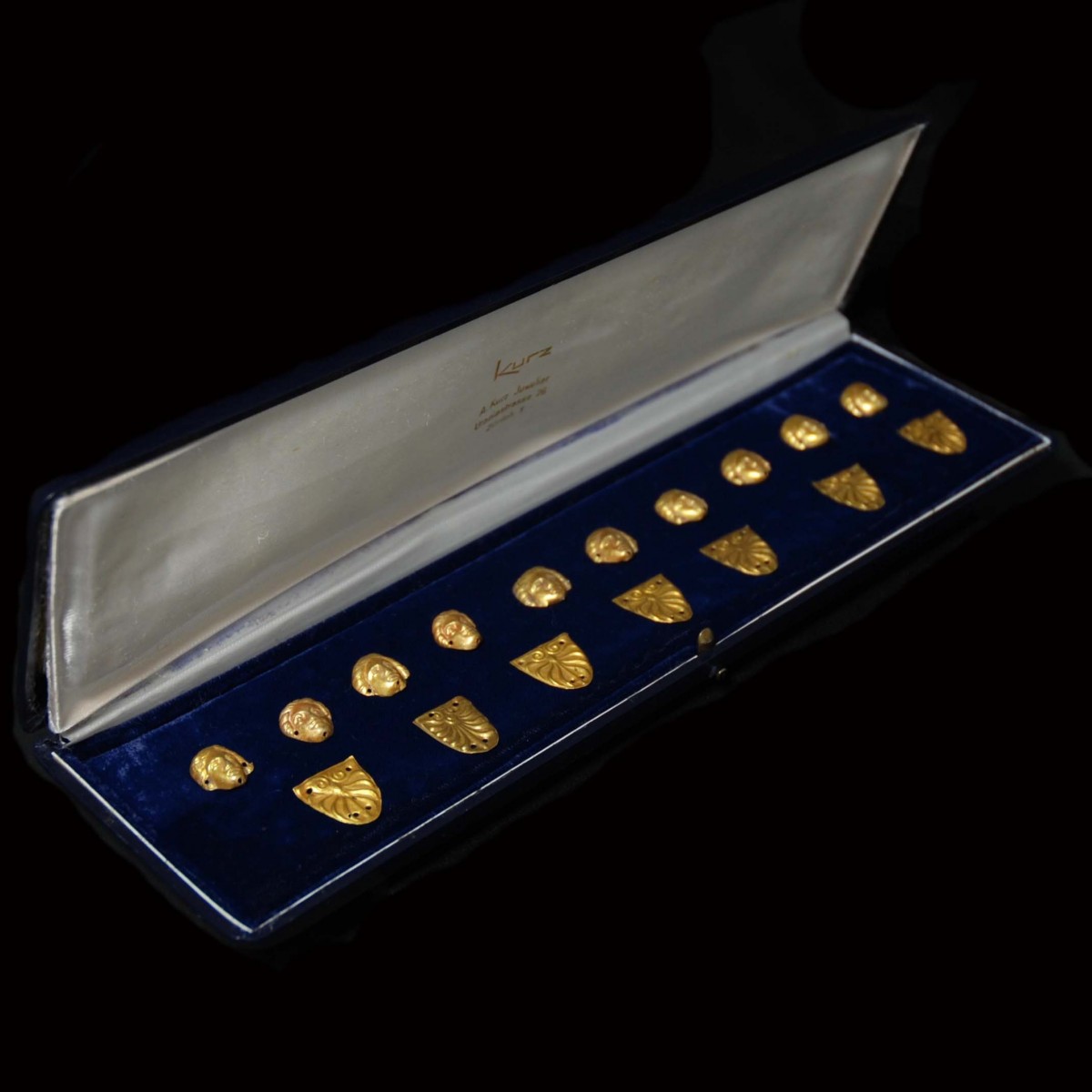
|
|
Greece – 5th-4th century B.C.
|
17 very finely worked out gold ornaments, which were once sewed on a high-quality textile. The collection consists of ten female heads, two of them still with archaic features with almond-shaped eyes and the typical smile. The other eight faces with classical features. All small heads with finely pulled back hair, even the strands are worked out. The perforations on the sides and also on the chin served for sewing on the textile. Furthermore seven gold sheets in form of palmettes belong to the collection. The symmetrical perforations, four on each palmette, also served for sewing on the gown. See for the type the almost identical gold appliques in the Metropolitan Museum of Art with the Accession Numbers 1999.289.3, 1999.289.4 and 1999.289.5. The collection comes with a jewellery box by Armin Kurz Juwelier, Zürich, Switzerland.
|
Provenance: From a Swiss private collection, acquired in the 1980s.
Dimensions: From 1.3 cm to 1.7 cm high (gold ornaments); 25.2 cm x 7.8 cm (dimensions of the jewellery box).
Price: 12 000 Euro
|
|
|
|
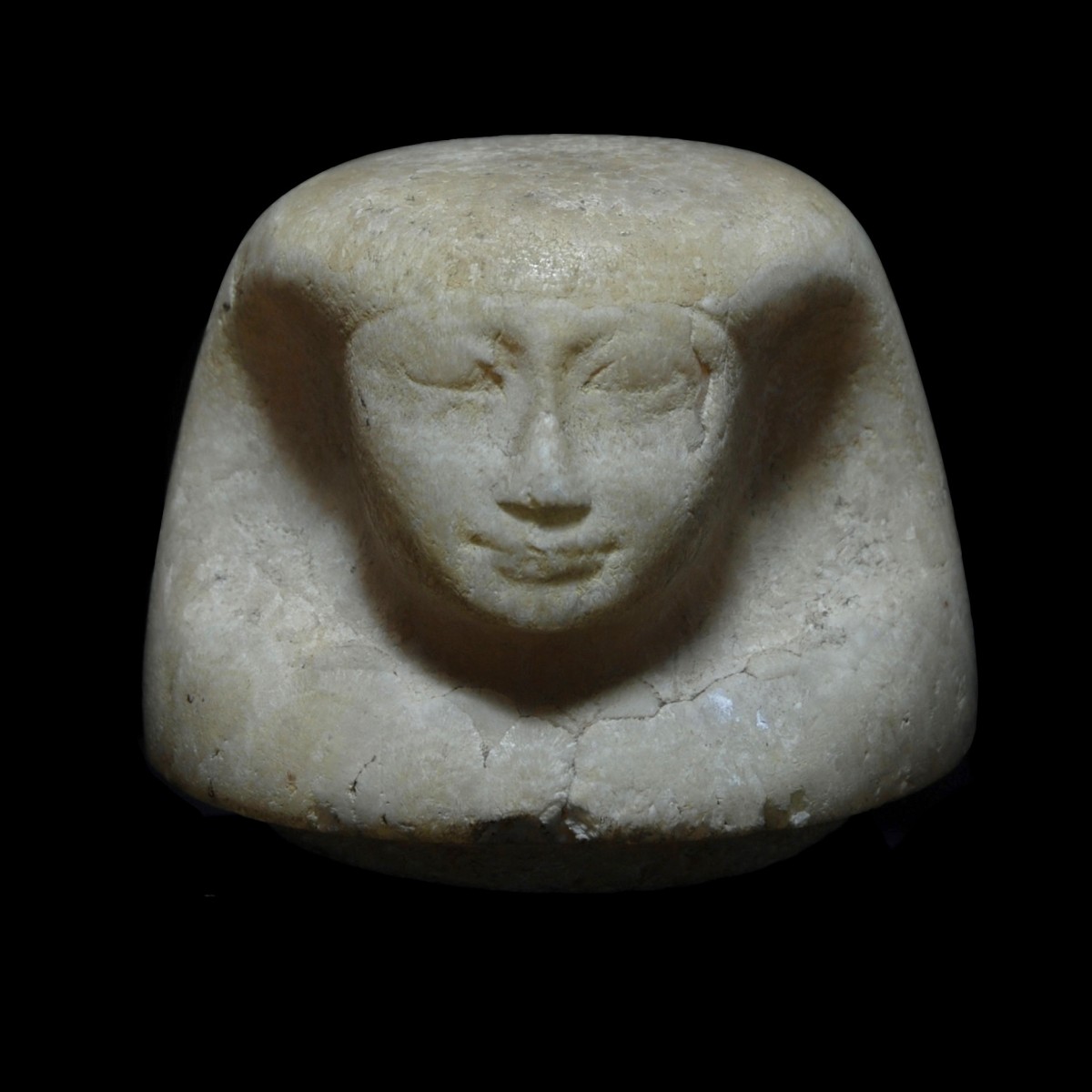
|
|
|
|
|
|
Egypt – New Kingdom, 19th-20th dynasty, 1292-1070 B.C.
|
Heavy, high-quality alabaster canopic jar lid with a human face embodying Horus’ son Imsety. The face with fine features, the mouth formed to a gentle smile. The wig is pulled down to the forehead and cascading on the sides over the shoulders to the front. At the bottom an inlet ring for inserting in the canopic jar. Imsety watches together with his three brothers Qebehsenuef, Hapy and Duamutef over the intestines of the embalmed deceased. He was responsible for protecting the liver.
|
Provenance: From an old Parisian private collection.
Dimensions: 11 cm x 13 cm
Price: 8 000 Euro
|
|
|
|
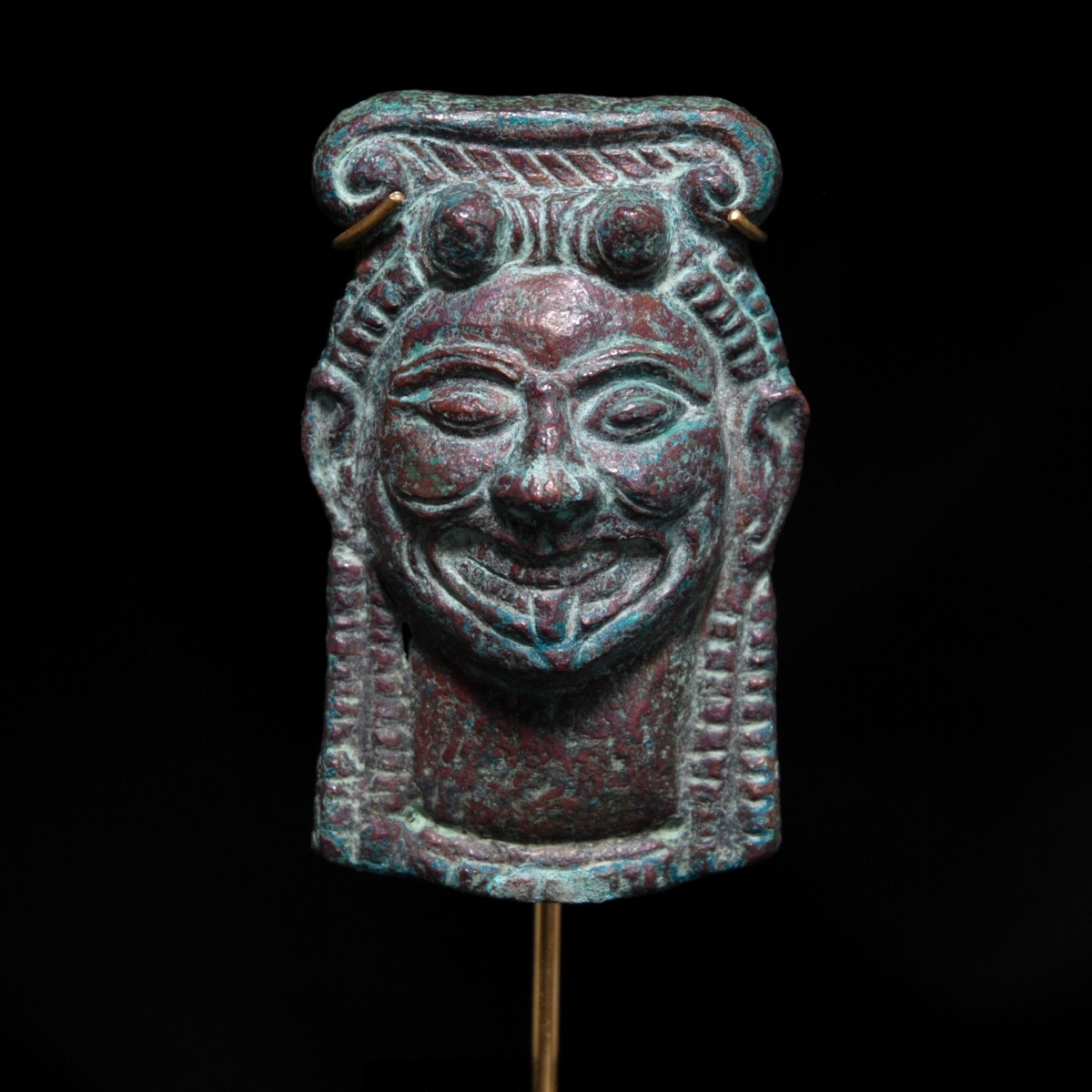
|
|
|
|
Etruria – 6th-5th century B.C.
|
Heavy archaic bronze applique in form of a Gorgon head (“Gorgoneion”). The head is elaborately worked out with almond-shaped eyes, humped nose and large ears. The mouth is wide open forming the typical grimace of the scary figure. Both rows of teeth are worked out, between them the tongue sticking out. The high, prominent cheekbones accentuate the distinctive expression of the Gorgon. The hair is long and cascades in corkscrew curls on the side. On the forehead two horns, above braided hair. The ending is formed by a band with curled ends which possibly can be interpreted as a stylized serpent. At the bottom two small perforations for mounting. The applique served as a decorative piece of a bronze jug or furniture. Magnificent cuprite patina. A rare depiction. Mounted.
|
Provenance: English private collection, acquired between 1960 and 1980.
Dimensions: 8.5 cm high
Price: 3 600 Euro
|
|
|
|
|
|
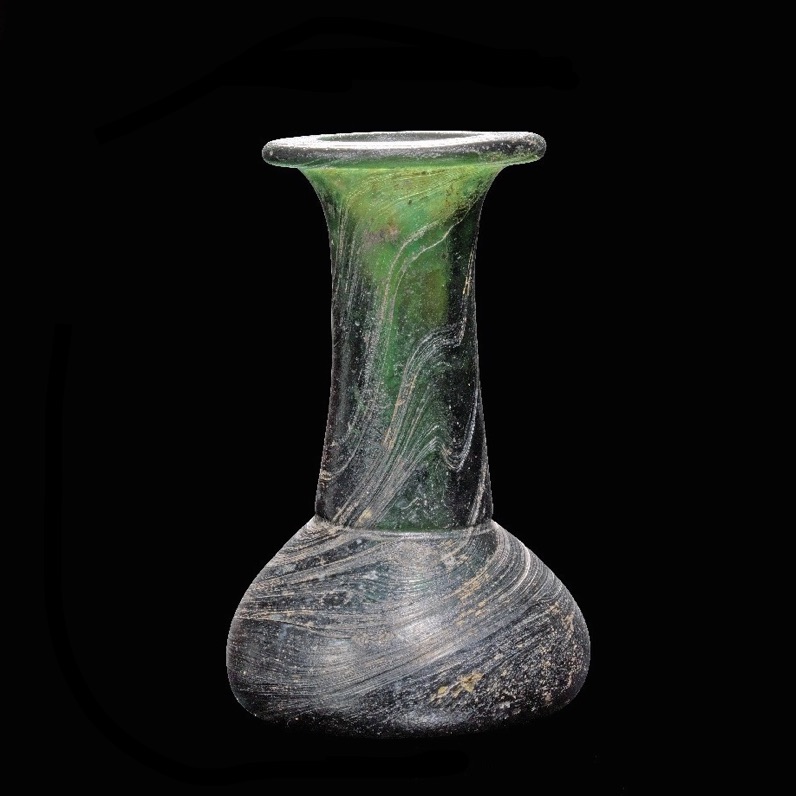
|
|
Roman Empire – 2nd century A.D.
|
Magnificent, translucent unguentarium made of thick-walled, dark green glass. The body is compressed pear-shaped, the base flat, circularly curved inwards. The neck is long and cylindrical, the lip horizontally protruding and thickened at the rim. Magnificent streaks creating a special elegance to the glass.
|
Provenance: Bavarian private collection A. L., acquired 2002 at the art shop Pfennings, Cologne, Germany.
Dimensions: 10 cm high
Price: 1 800 Euro
|
|
|
|
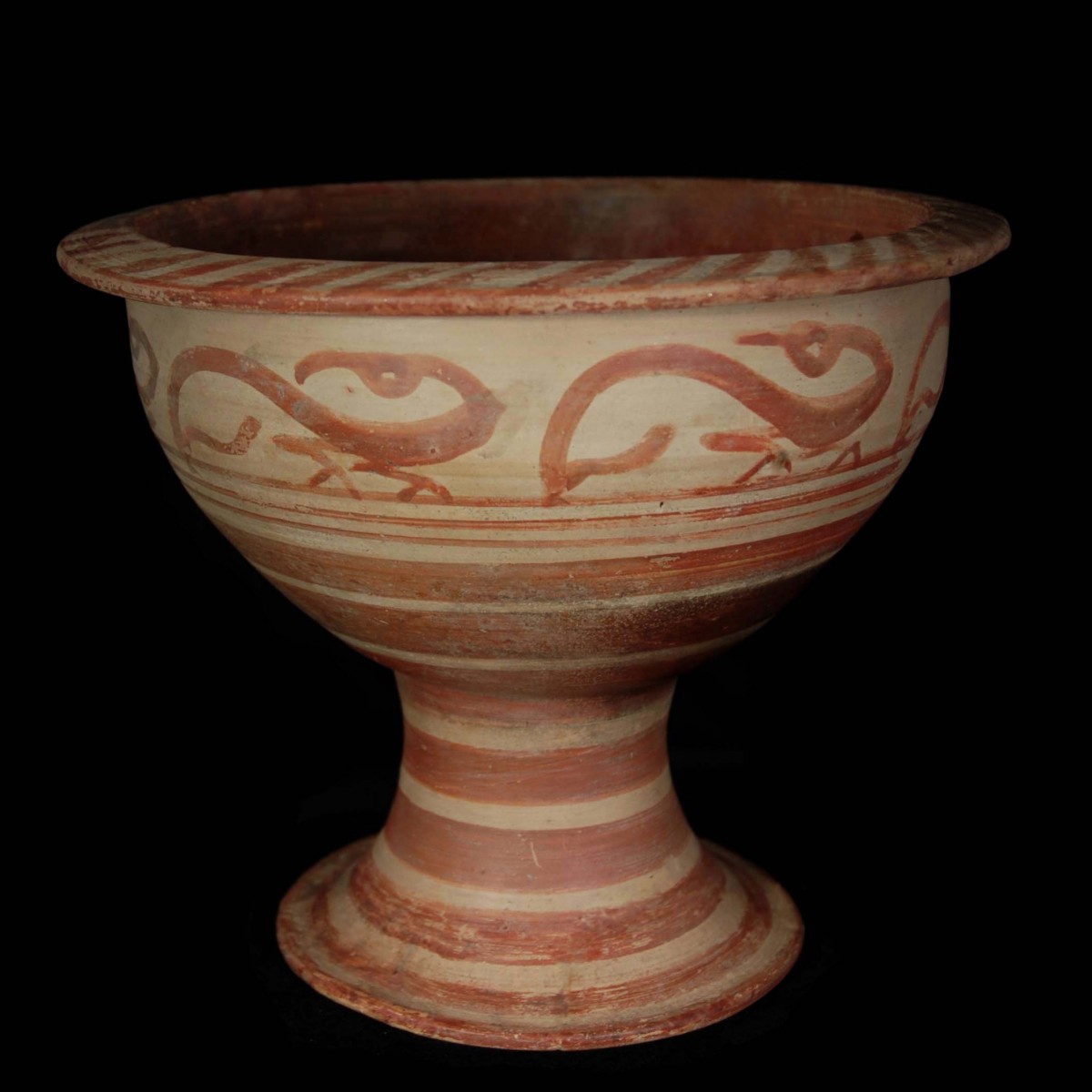
|
|
|
|
Etruria – 7th century B.C.
|
Large terracotta bowl on a high foot. The vessel made of beige clay with reddish brown painting. Thick red-brown ribbons are painted around the foot and up to about half of the corpus. Stripe decoration on the rim. Under the rim a frieze of seven stylized birds, which are interpreted as herons and therefore name the painter's workshop "Heron". Inside the bowl broad red-brown bands.
|
Provenance: From the inventory of the judicially dissolved Parisian gallery La Reine Margot.
Dimensions: 20.5 cm high; 24.8 cm in diameter
Price: 2 200 Euro
|
|
|
|

|
|
|
|
|
Hand made terracotta horse with rider. The animal with straight legs, small head and short tail. The rider is also depicted in stylized form. His arms are stretched forward and holding the horse on its neck. His body is straight, the short legs, on the sides slightly put forward. He has a large nose, beard and wears a helmet. Color remains. Possibly from Cyprus.
|
Provenance: From the inventory of the judicially dissolved Parisian gallery La Reine Margot. Listed there with the inventory number 8382.
Dimensions: 9.8 cm x 6.8 cm
Price: 800 Euro
|
|
|
|
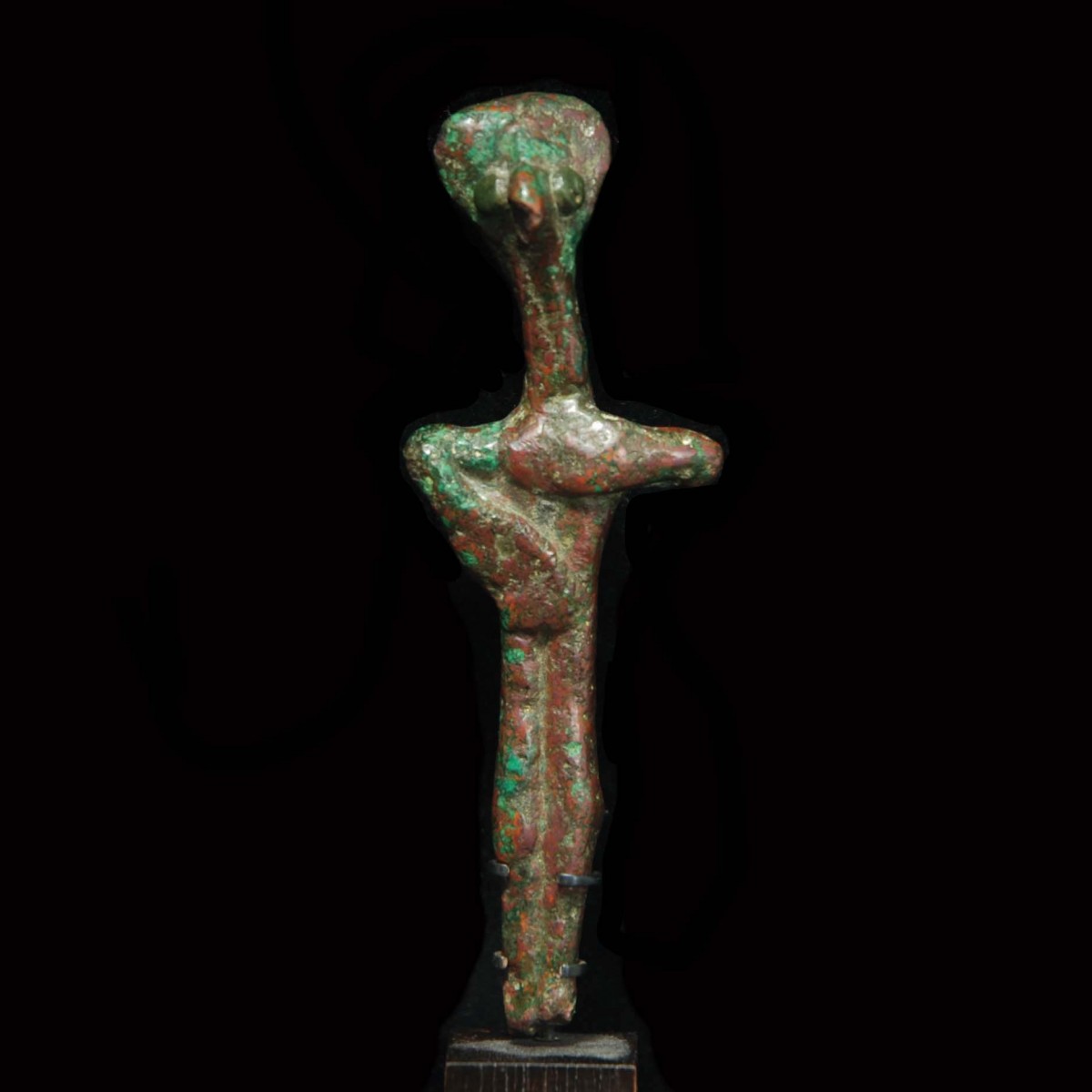
|
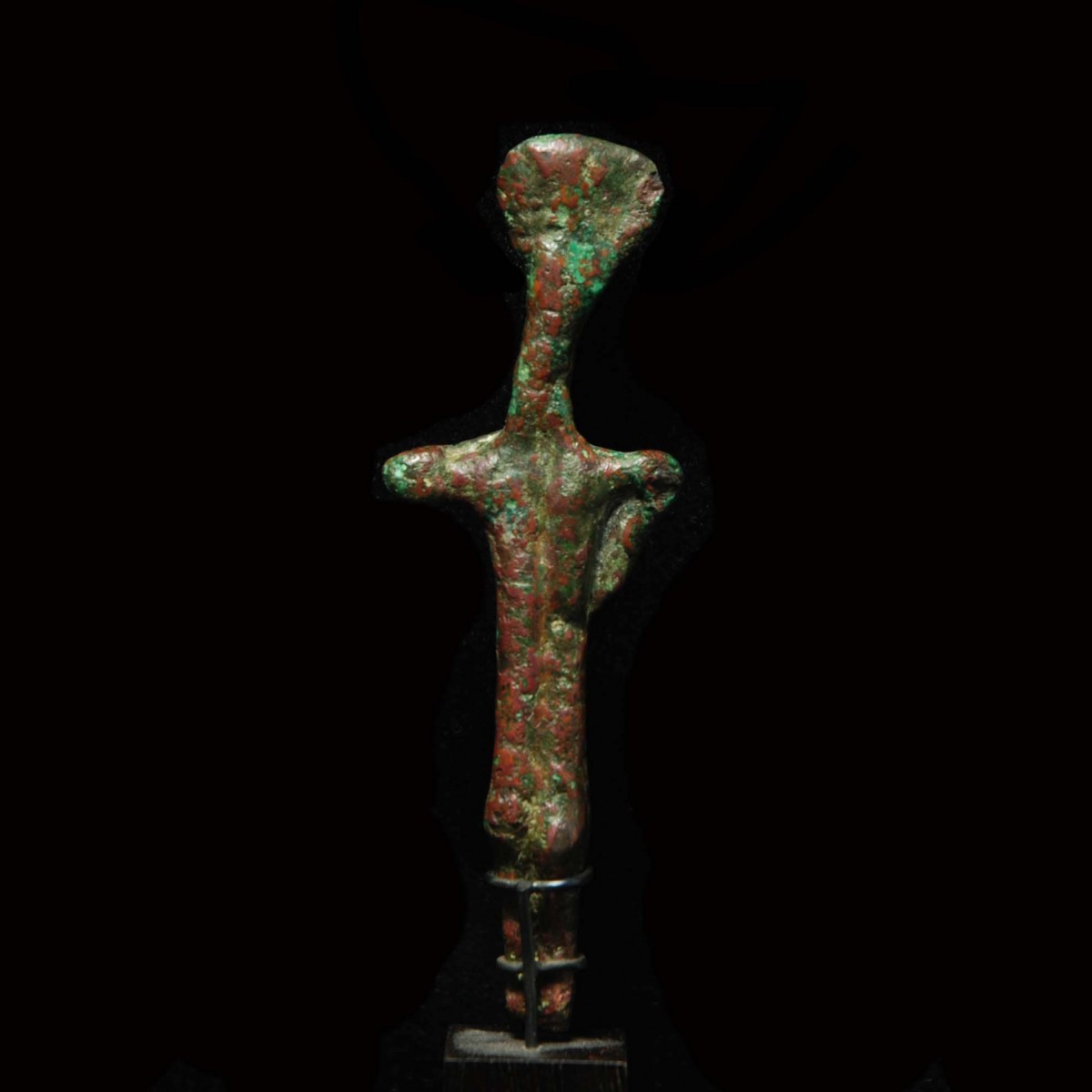
|
|
Levant – Early 2nd millennium B.C.
|
Stylized bronze figure of a woman with an oversized, flat head, knob-like eyes and the large nose creating the typical bird face. The long neck followed by a short upper body. The woman places her left hand on her chest, her right one on her belly. The long, rod-shaped legs are straight and together. On an old wood base.
|
Provenance: From the inventory of the judicially dissolved Parisian gallery La Reine Margot. There listed with the inventory number 3531.
Dimensions: 7.5 cm high
Price: 800 Euro
|
|
|
|
Three Fragments of Sumerian Cuneiform Bricks with Inscriptions from King Amar-Sin (2046-2038 B.C.).
Provenance: German Collection Gerhard Staschen since 1981/82:
|
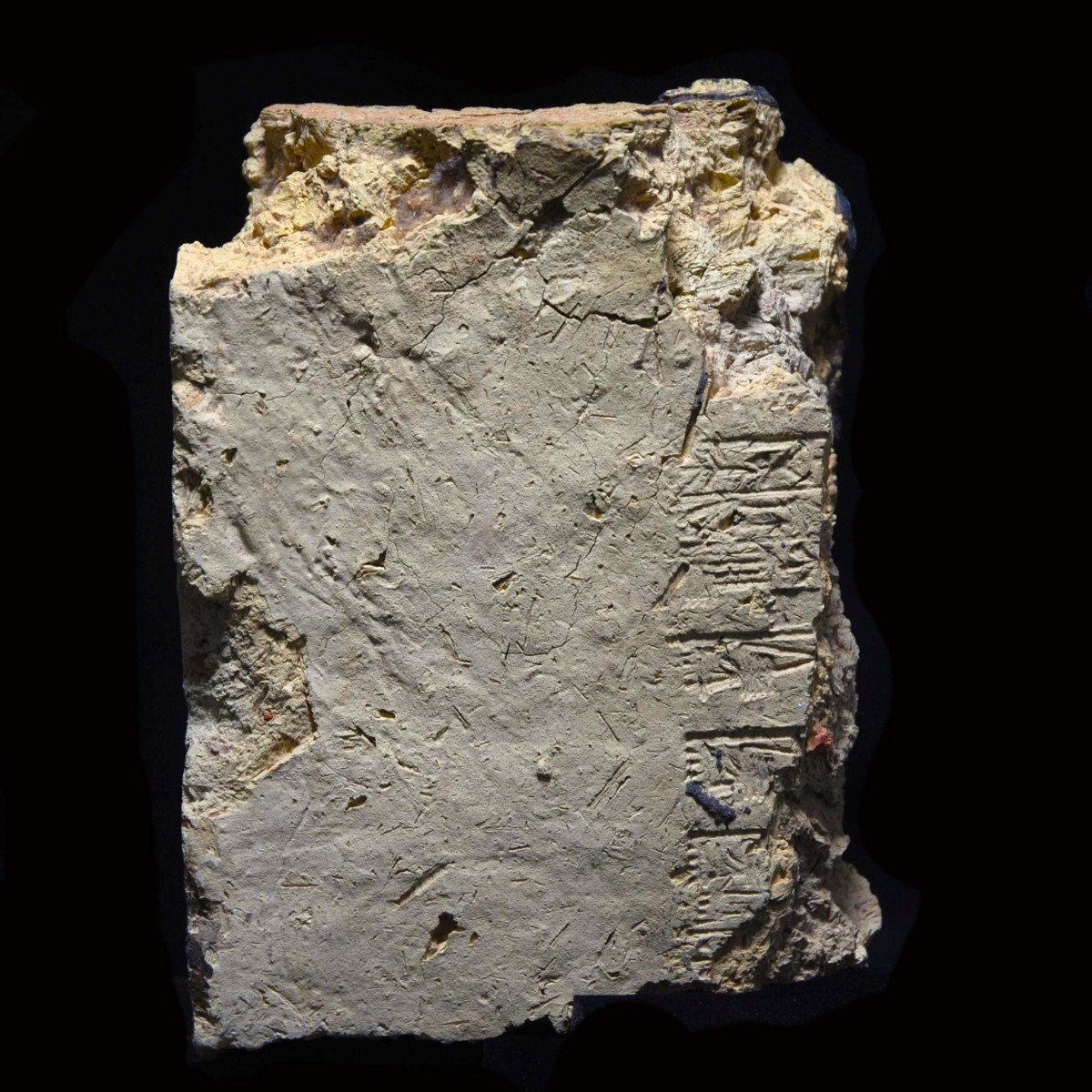
|
Fragment of a clay brick with an inscription bearing the name of Amar-Sin, the third king of the third dynasty of Ur. Amar-Sin is known today for making efforts to restore the ancient sites of Sumer. The upper left part of the original 13-line inscription has been preserved. "Amar-Suen, the one called by (the god) Enlil in (the town) Nippur, supporter of the temple of Enlil, the strong king, king of Ur, king of the four (world) quarters, for (the god) Enki his beloved lord, he (i.e., Amar-Suen) built his (i.e, Enki’s) beloved (temple) Abzu." The reverse with a thick, preserved layer of the original bitumen with which the brick, illegible from the outside, was processed into the masonry
|
Dimensions: 19 cm x 12.8 cm
Price: 900 Euro
|
|
|
|
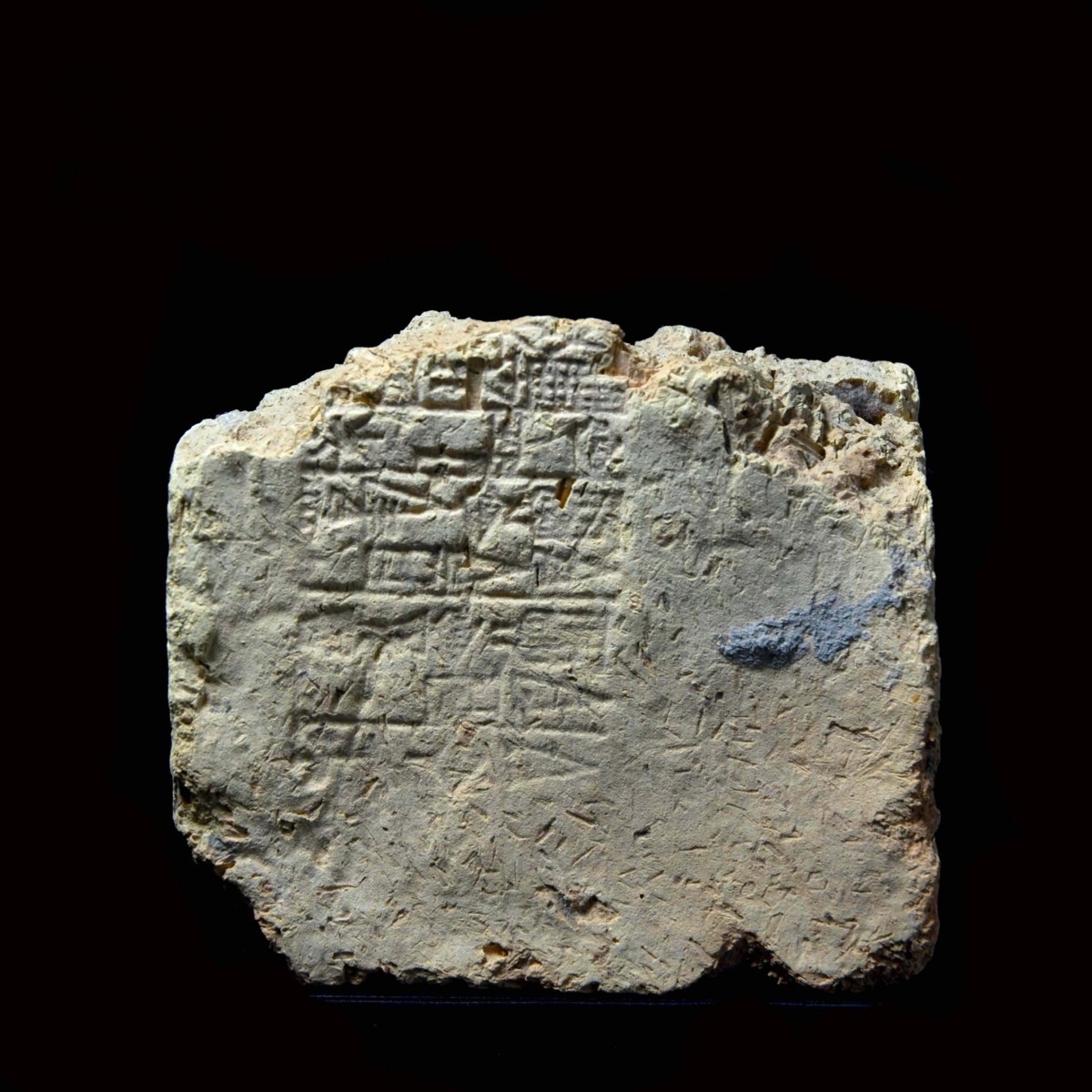
|
Fragment of a clay brick with an inscription bearing the name of Amar-Sin, the third king of the third dynasty of Ur. Amar-Sin is known today for making efforts to restore the ancient sites of Sumer. The bottom half of the original 13-line inscription has been preserved. The translation reads: "(Amar-Suen)..., supporter of the temple of Enlil, the strong king, king of Ur, king of the four (world) quarters, for (the god) Enki his beloved lord, he (i.e., Amar-Suen) built his (i.e, Enki’s) beloved (temple) Abzu."
|
Dimensions: 11.3 cm x 12.8 cm
Price: 1 200 Euro
|
|
|
|
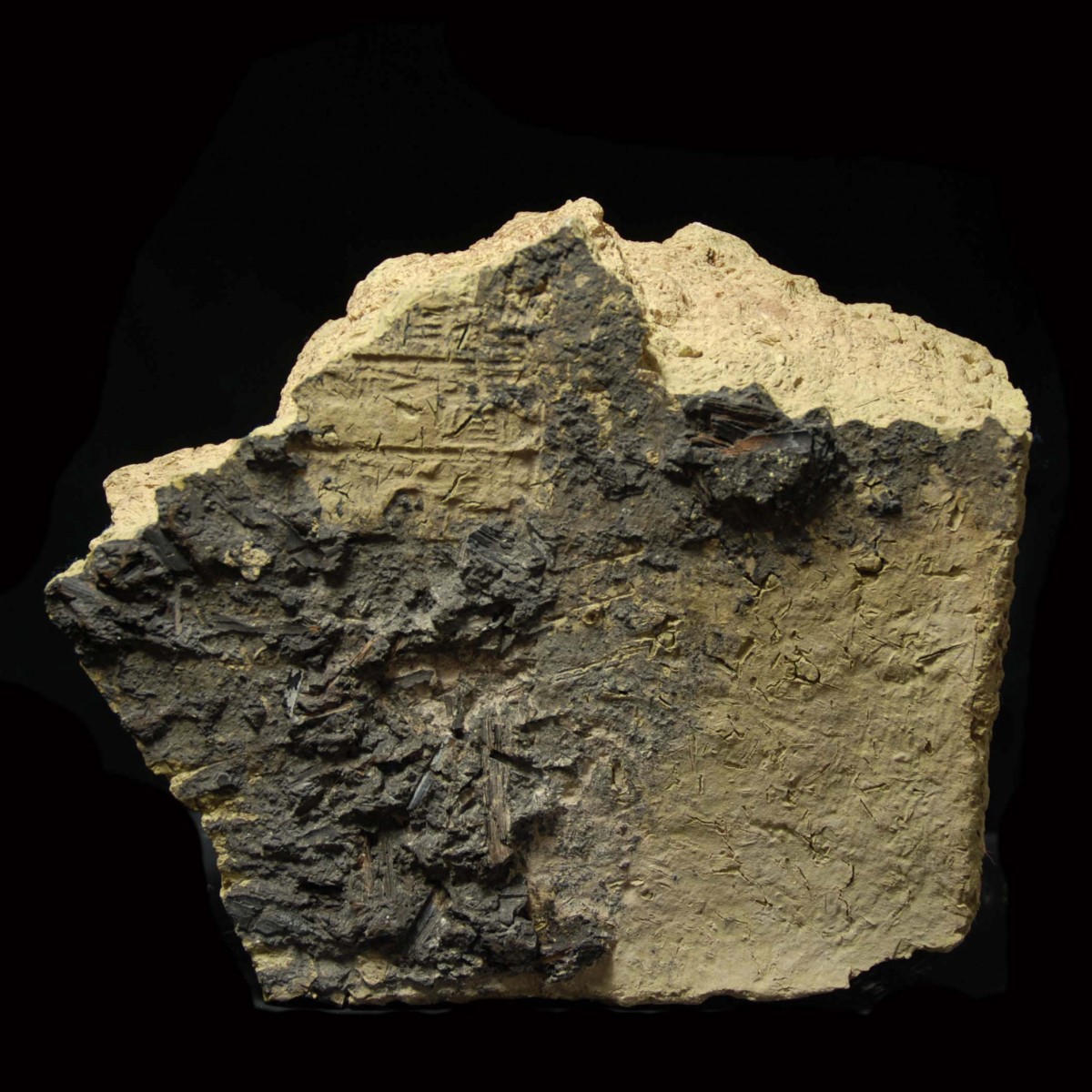
|
Fragment of a clay brick with an inscription bearing the name of Amar-Sin, the third king of the third dynasty of Ur. Amar-Sin is known today for making efforts to restore the ancient sites of Sumer. A part of the original 13-line inscription has been preserved. "Amar-Suen, the one called by (the god) Enlil in (the town) Nippur, supporter of the temple of Enlil, the strong king, king of Ur, king of the four (world) quarters, for (the god) Enki his beloved lord, he (i.e., Amar-Suen) built his (i.e, Enki’s) beloved (temple) Abzu." Both sides with a partly thick preserved layer of the original bitumen with which the brick, illegible from the outside, was processed into the masonry.
|
Dimensions: 18.2 cm x 21.2 cm
Price: 800 Euro
|
|
|
|
|
|
Die große Frühjahrsausstellung:
"Die ewige Schönheit Ägyptens"
|
Es ist gleichsam eine Renaissance: Während zahlreiche Länder der Welt aus den Lockdowns erwachen, beginnt auch das Kunstleben vielerorts wieder zu erblühen. Ab Mai werden wir auch in Wien wieder unsere Galerien eröffnen, und wir werden diese Eröffnung ganz besonders zelebrieren: Mit einer Ausstellung in unserem Showroom über "Die ewige Schönheit Ägyptens". Dabei zeigen wir Objekte von musealer Bedeutung wie die bronzene Sonnenbarke aus der Spätzeit, von der es weltweit nur zwei vergleichbare Beispiele gibt – eine in Kairo, die andere in Lissabon. Wir präsentieren einzigartige Tiermumien, darunter die der Katze aus der weltberühmten Sammlung Hilton-Price. Und: Wir stellen neben neu erworbenen Reliefs erstmals auch die eindrucksvolle Kollektion aus nicht weniger als zehn monumentalen Sarkophag- und Mumienmasken aus, die wir Anfang des Jahres in Frankreich erwerben konnten.
|
Besuchen Sie uns ab 3. Mai täglich von 10.00 bis 18.00 in der Unteren Viaduktgasse 55. Wir freuen uns auf ein persönliches Wiedersehen umgeben von der "ewigen Schönheit Ägyptens".
|
|
|
|
Unser Highlight des Monats:
|
|
Ägypten – Spätzeit, 26. bis 30. Dynastie, 380-343 v. Chr.
|
Eine der wenigen erhalten gebliebenen Bronze-Aufsätze einer Sonnenbarke, die in der Spätzeit für Prozessionen und Zeremonien verwendet wurden. Die Barke mit halbrundem Schiffsrumpf, von dessen Mitte unten ein zylinderförmiger Fortsatz ausgeht, auf dem der Aufsatz aufgesteckt wurde. Bug und Heck in Form stilisierter Lotusblüten, knapp unter dem Heck zwei Ösen. In der Mitte der Barke ein Naos, dessen Seitenwände durchbrochen gearbeitet sind. Davor steht der falkenköpfige Gott Horus mit Doppelkrone (Pschent) flankiert von den Göttinnen Isis und Nephthys. Der Naos bekrönt durch einen Horusfalken mit Pschent. Abgesehen von dieser Bronze-Sonnenbarke sind nur zwei weitere komplette bekannt. Die bekanntere ist die des Pharaos Djedhor im Calouste Gulbenkian Museum in Lissabon (Inventarnummer 168). Im ägyptischen Museum wird eine weitere komplette Bronze-Barke aufbewahrt, ein Fragment ist im Museum Vleehuis in Antwerpen (Accession Number 79.1). Gesockelt.
|
Provenance: Privatsammlung des französischen Architekten Michel Holley, erworben am 20. Oktober 1972. Mit französischem Antikenpass und einem Foto aus dem Jahr 1972, das die Barke zeigt.
Dimensionen: 30 cm x 24 cm
Price: 80.000 Euro
|
|
|
|
Ausgewählte Kunstwerke des Monats:
|
|
Ägypten – Ptolemäische Zeit, 332-30 v. Chr.
|
In braunes Leinen gewickelte Mumie einer Katze. Der Körper zylinderförmig verschnürt und rückseitig zugenäht. Der Kopf modelliert, Maul, Vibrissen, Nase und Augen aufgemalt. Die Ohren aufgestellt. Seitlich ein altes Sammlungsetikett. Ein beigelegtes Etikett verweist auf den Fundort Beni Hassan. Publiziert in: „A Catalogue of the Egyptian Antiquities in the Posession of F. G. Hilton-Price", Dir. S.A., London 1897, Seite 317, Nummer 2074. Katzenmumien wie diese wurden zu Ehren der Göttin Bastet geopfert. Kaufte ein Gläubiger eine Katze nach seiner Wahl, wurde diese von einem Priester getötet. Die tote Katze wurde daraufhin durch den Priester dem gleichen traditionellen Prozess der Mumifizierung unterzogen, der auch bei Menschen üblich war. Der Käufer legte die Mumie daraufhin in eine speziell für den Zweck der Katzen-Opferung verwendete Grabkammer. Gesockelt.
|
Provenienz: Privatsammlung F. G. Hilton-Price vor 1897. Danach versteigert bei Sotheby, Wilkinson & Hodge London im Juli 1911, Los 1024. Mit Original-Auktions-Sticker. Danach in Privatbesitz. Zuletzt im englischen Kunsthandel.
Höhe: 57 cm
Preis: 14.000 Euro
|
|
|
|
|
Zypern – 7. Jahrhundert v. Chr.
|
In dieser Qualität und Größe äußerst seltene Terrakotta-Statuette eines Kriegers aus archaischer Zeit. Der auf der Töpferscheibe geformte Körper ist zylinderförmig und innen hohl. Der oben spitz zulaufende Kopf mit halbrunden, abstehenden Ohren, langer spitzer Nase und aufgemalten Augen und Bart. Der Krieger trägt einen Helm mit nach hinten gedrehtem Kamm. In der linken Hand hält er einen kreisrunden Schild mit knopfartigem Buckel. In der zur Seite gestreckten rechten Hand hielt er wohl einen Speer. Prachtvoll erhaltene rote und schwarze Bemalung. Figuren wie diese wurden im Heiligtum Agia Irini und anderen ländlichen Schreinen auf Zypern gefunden. Vergleiche zum Typus den Krieger im Medelhvsmuseet in Stockholm mit der Inventarnummer A.I. 0342.
|
Provenienz: Alte New Yorker Privatsammlung. Danach US-Privatsammlung Darly Gruber Kulok (1960-2019). Dort erworben von der Galerie Art of Eternity New York. Zuletzt in der Auktion “Exceptional Antiquties, Asian, Ethnographic“ am 13. Februar 2020, Los 17e. Mit TL-Test.
Höhe: 19,7 cm
Preis: 12.000 Euro
|
|
|
|
|
Ägypten – Ptolemäische Zeit, 332-30 v. Chr.
|
Großes Fragment eines versenkten Kalkstein-Reliefs, das den Kopf eines Pharaos zeigt. Er trägt eine kurze Perücke mit eng gesetzten Locken, die sogenannte Ibes-Perücke, die von dem Sesched-Stirnband mit rückwärtiger Schleife umgeben ist. Das Haarband gilt als Zeichen der Wiedergeburt und war im Totenglauben von großer Bedeutung. An der Stirn sitzt ein Uräus. Der Pharao trägt die Mondkrone des Chons als Kopfschmuck, unten mit der Sichel des Neumondes, oben mit dem Vollmond. Es handelt sich demnach um eine vergöttlichte Darstellung des Königs in Referenz zum Mondgott Chons. Mit roten Farbresten. Gesockelt.
|
Provenienz: Privatsammlung des Baseler Professors Dr. Roland Bay, erworben 1950. Danach in der Pariser Privatsammlung F. A., 1960er bis 1970er Jahre. Zuletzt bei Jerome Eisenberg in der Galerie Royal Athena in New York. Mit französischem Antikenpass.
Dimensionen: 22,7 cm x 29,6 cm
Preis: 10.000 Euro
|
|
|
|
|
Griechenland – 1400-1300 v. Chr.
|
Stilisiertes Idol einer weiblichen Adorantin, das aufgrund seiner Form nach dem griechischen Buchstaben Φ (Phi) benannt ist. Der vogelähnliche Kopf mit langer, halbrunder Nase und nach hinten aufsteigender Kalotte. Ein langer Haarzopf fällt hinten bis über die Mitte der Figur hinab. Der flache Oberkörper ist kreisrund, die kleinen Brüste sind kugelig. Der Oberkörper geht in einen ebenfalls stilisierten, zylinderförmigen Unterkörper über, der sich zum Fuß hin zu einem Standring öffnet. Der gesamte Körper ist mit wellenförmigen, rotbraunen Linien dekoriert. Am Unterkörper senkrechte rote Linien. Am Hals und zwischen Ober- und Unterkörper eine horizontale Trennlinie.
|
Provenienz: Aus dem Bestand der gerichtlich aufgelösten Pariser Galerie La Reine Margot.
Höhe: 10 cm
Preis: 6.000 Euro
|
|
|
|
|
Griechenland – 5.-4. Jahrhundert v. Chr.
|
17 überaus fein gearbeitete Goldornamente, die einst auf hochwertige Textilien aufgenäht waren. Die Sammlung besteht aus zehn Frauenköpfen, zwei davon noch mit archaischen Zügen mit Mandelaugen und dem typischen Lächeln. Die anderen acht Gesichter mit klassischen Zügen. Alle Köpfchen mit fein nach hinten gezogenen Haaren, in denen selbst die Strähnen ausgearbeitet sind. Seitliche Lochungen und Lochungen am Kinn dienten zum Aufnähen am Textil. Darüber hinaus gehören sieben Goldplättchen in der Form von Palmetten zur Sammlung. Die symmetrischen Lochungen, jeweils vier pro Palmette, dienten ebenfalls zum Aufnähen auf die Kleidung. Vergleiche zum Typus die nahezu identen Gold-Applikationen im Metropolitan Museum of Art mit den Accession Numbers 1999.289.3, 1999.289.4 und 1999.289.5. Die Sammlung mit dazugehöriger Schmuckschatulle von Armin Kurz Juwelier, Zürich.
|
Provenienz: Aus Schweizer Privatsammlung, erworben in den 1980er Jahren.
Dimensionen: Höhe Goldornamente von 1,3 cm bis 1,7 cm; Dimensionen Schatulle 25,2 cm x 7,8 cm
Preis: 12.000 Euro
|
|
|
|
|
Ägypten – Neues Reich, 19.-20. Dynastie, 1292-1070 v. Chr.
|
Hochwertig gearbeiteter, schwerer Kanopendeckel aus Alabaster mit menschlichem Gesicht, der den Horus-Sohn Amset verkörpert. Das Gesicht mit sehr feinen Zügen, der Mund sanft zu einem Lächeln geformt. Die Perücke ist bis in die Stirn gezogen und fällt seitlich über die Schultern nach vorn. Im Unterteil Einlassring zum Einsetzen in den Kanopenkrug. Amset wacht mit seinen drei Brüdern Kebechsenuef, Hapi und Duamutef über die Eingeweide der einbalsamierten Verstorbenen. Ihm unterstand dabei der Schutz der Leber.
|
Provenienz: Aus alter Pariser Privatsammlung.
Dimensionen: 11 cm x 13 cm
Preis: 8.000 Euro
|
|
|
|
|
Etrurien – 6.-5. Jahrhundert v. Chr.
|
Schwere archaische Bronze-Applike in Form eines Gorgonenhaupts („Gorgoneion“). Der Kopf sehr detailreich gearbeitet mit mandelförmigen Augen, buckliger Nase und großen Ohren. Der Mund ist zur typischen Fratze der Schreckgestalt aufgerissen. Beide Zahnreihen sind ausgearbeitet, dazwischen die lange, herausgestreckte Zunge. Die hohen, weit hervorstehenden Backenknochen verstärken den markanten Ausdruck der Gorgone. Das Haar ist lang und fällt in Korkenzieherlocken seitlich herab. Auf der Stirn zwei Hörner, darüber geflochtenes Haar. Den Abschluss bildet ein Band mit eingerollten Enden, das wohl als stilisierte Schlange zu deuten ist. Unten zwei kleine Lochungen zur Fixierung. Die Applike diente als dekorativer Teil einer Bronzekanne oder eines Möbels. Prachtvolle Kupritpatina. Eine seltene Darstellung. Gesockelt.
|
Provenienz: Englische Privatsammlung zwischen 1980 und 1990.
Höhe: 8.5 cm
Preis: 3.600 Euro
|
|
|
|
|
Römisches Reich – 2. Jahrhundert n. Chr.
|
Prachtvolles durchscheinendes Unguentarium aus dickwandigem, dunkelgrünem Glas. Der Korpus gestaucht birnenförmig, die Basis flach, nach innen kreisförmig gewölbt. Der Hals ist lang und zylinderförmig, die Lippe horizontal ausladend und am Rand heiß verdickt. Herrliche Schlieren, die dem Glas eine besondere Eleganz verleihen.
|
Provenienz: Bayrische Privatsammlung A.L., erworben 2002 in der Kunsthandlung Pfennings, Köln.
Höhe: 10 cm
Price: 1.800 Euro
|
|
|
|
|
Etrurien – 7. Jahrhundert v. Chr.
|
Große Terrakotta-Schale auf hohem Standfuß. Das Gefäß aus beigem Ton mit rotbauner Bemalung. Um den Fuß und bis etwa zur Hälfte des Korpus sind dicke rotbraune Bänder aufgemalt. Am Rand Steifendekor. Unter dem Rand ein Fries von sieben stilisierten Vögeln, die als Reiher gedeutet werden und der Maler-Werkstatt den englischen Namen „Heron“ geben. Im Inneren der Schale breite rotbraune Bänder.
|
Provenienz: Aus dem Bestand der gerichtlich aufgelösten Pariser Galerie La Reine Margot.
Dimensionen: Höhe 20,5 cm; Durchmesser 24,8 cm
Preis: 2.200 Euro
|
|
|
|
Handgeformtes Terrakotta-Pferd mit Reiter. Das Tier mit geraden Beinen, kleinem Kopf und kurzem Schwanz. Der Reiter ebenfalls stilisiert dargestellt. Er hat beide Arme nach vorne gestreckt und hält das Pferd am Hals. Sein Körper sitzt aufrecht, die kurzen Beine seitlich leicht nach vorne gelegt. Er hat eine große Nase, Bart und trägt einen Helm. Reste von Bemalung. Wohl aus Zypern.
|
Provenienz: Aus dem Bestand der gerichtlich aufgelösten Pariser Galerie La Reine Margot. Dort mit der Inventarnummer 8382 gelistet.
Dimensionen: 9,8 cm x 6,8 cm
Price: 800 Euro
|
|
|
|
|
Levante – Anfang 2. Jahrtausend v. Chr.
|
Stilisierte Bronzefigur einer Frau mit übergroßem, flachem Kopf, Knopfaugen und der großen Nase, die ihr das typische „Vogelgesicht“ verleiht. Der lange Hals geht in einen kurzen Oberkörper über. Die Frau legt ihre linke Hand auf die Brust, die rechte auf den Bauch. Die langen, stabförmigen Beine sind gerade und geschlossen. Auf altem Holzsockel.
|
Provenienz: Aus dem Bestand der gerichtlich aufgelösten Pariser Galerie La Reine Margot. Dort mit der Inventarnummer 3531 gelistet.
Höhe: 7,5 cm
Preis: 800 Euro
|
|
|
|
Drei Fragmente sumerischer Keilschriftziegel mit Inschriften des Königs Amar-Sin (2046-2038 v. Chr.).
Provenienz: Deutsche Sammlung Gerhard Staschen seit 1981/82:
|
|
Sumer – 2046-2038 v. Chr.
|
Fragment eines Tonziegels mit einer Inschrift, die den Namen des Amar-Sin, des dritten Königs der dritten Dynastie von Ur trägt. Amar-Sin ist heute bekannt dafür, dass er sich bemühte, die alten Stätten von Sumer wieder in Stand zu setzen. Erhalten ist der linke obere Teil der ursprünglich 13-zeiligen Inschrift. "Amar-Sin, der Einzige, gerufen vom Gott Enlil in der Stadt Nippur, Unterstützer des Tempels von Enlil, der starke König, der König von Ur, der König der vier Teile von Himmel und Erde, für den Gott Enki, seinen geliebten Gott, hat er (Amar-Sin) seinen geliebten (Tempel) Abzu errichtet." Die Rückseite mit einer dick erhaltenen Schicht des Original-Bitumens, mit dem der Ziegel, unlesbar von außen, im Mauerwerk verarbeitet war.
|
Dimensionen: 19 cm x 12.8 cm
Preis: 900 Euro
|
|
|
|
|
Sumer – 2046-2038 v. Chr.
|
Fragment eines Tonziegels mit einer Inschrift, die den Namen des Amar-Sin, des dritten Königs der dritten Dynastie von Ur trägt. Amar-Sin ist heute bekannt dafür, dass er sich bemühte, die alten Stätten von Sumer wieder in Stand zu setzen. Erhalten ist die untere Hälfte der ursprünglich 13-zeiligen Inschrift. Die Übersetzung lautet: "(Amar-Sin) …, Unterstützer des Tempels von Enlil, der starke König, der König von Ur, der König der vier Teile von Himmel und Erde, für den Gott Enki, seinen geliebten Gott, hat er (Amar-Sin) seinen geliebten (Tempel) Abzu errichtet." Unrestauriert.
|
Dimensionen: 11.3 cm x 12.8 cm
Preis: 1.200 Euro
|
|
|
|
|
Sumer – 2046-2038 v. Chr.
|
Fragment eines Tonziegels mit einer Inschrift, die den Namen des Amar-Sin, des dritten Königs der dritten Dynastie von Ur trägt. Amar-Sin ist heute bekannt dafür, dass er sich bemühte, die alten Stätten von Sumer wieder in Stand zu setzen. Erhalten ist ein Teil der ursprünglich 13-zeiligen Inschrift. "Amar-Sin, der Einzige, gerufen vom Gott Enlil in der Stadt Nippur, Unterstützer des Tempels von Enlil, der starke König, der König von Ur, der König der vier Teile von Himmel und Erde, für den Gott Enki, seinen geliebten Gott, hat er (Amar-Sin) seinen geliebten (Tempel) Abzu errichtet." Beide Seiten mit einer teilweise dick erhaltenen Schicht des Original-Bitumens, mit dem der Ziegel, unlesbar von außen, im Mauerwerk verarbeitet war.
|
Dimensionen: 18.2 cm x 21.2 cm
Preis: 800 Euro
|
|
|
|
|
|
|
CHRISTOPH BACHER ARCHÄOLOGIE ANCIENT ART GmbH
|
Galerie: Stubenring 20, A-1010 Wien
Showroom: Untere Viaduktgasse 55, A-1030 Wien
|
|
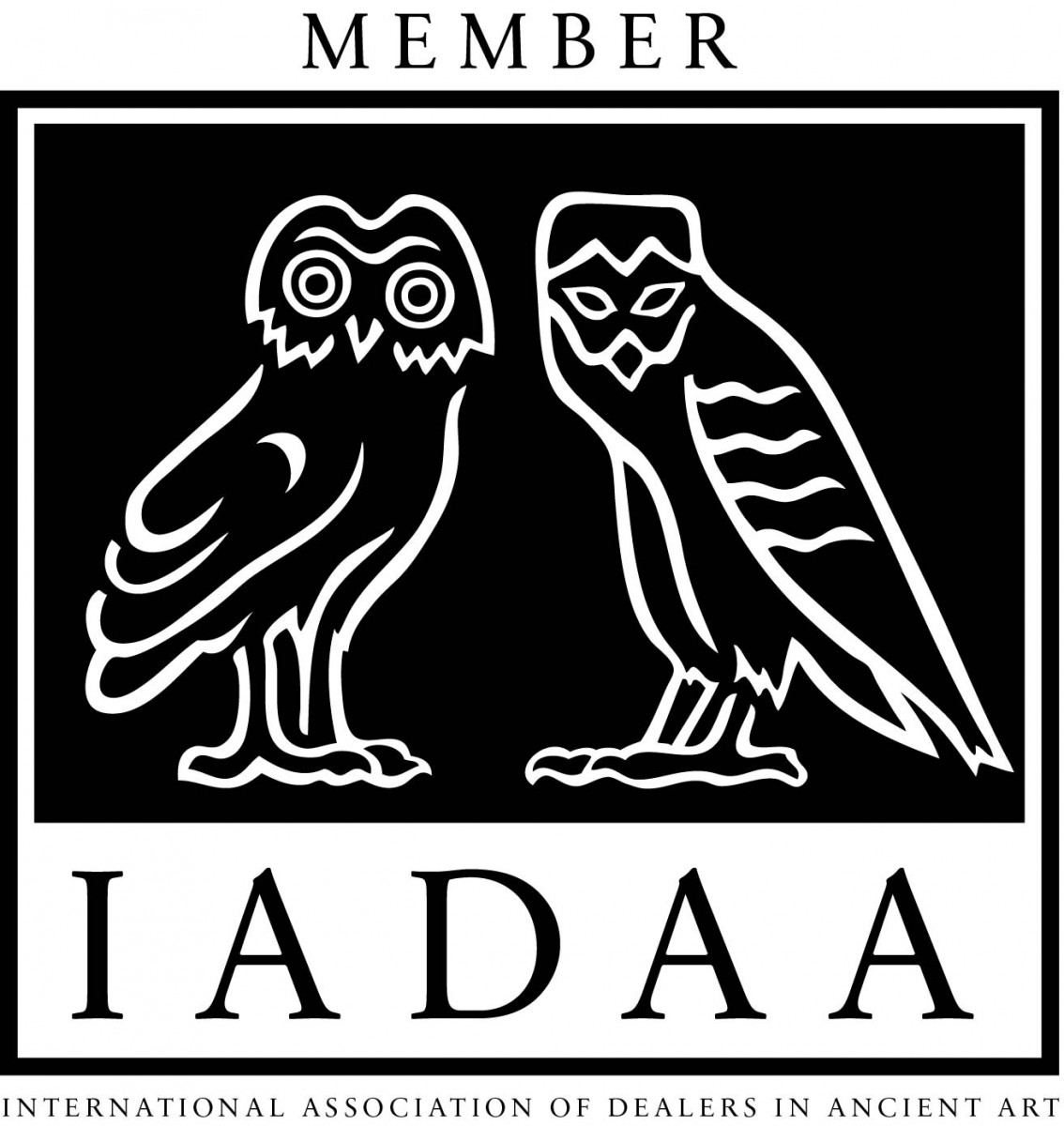
|
|
|
|